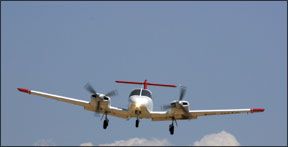Of all the changes general aviation has gone through in the past 20 years, the piston twin arguably has borne the brunt. Fuel prices, plus improved engine and systems reliability, have made piston twins less desirable than in their heyday of the 1960s and 70s. And for the same money as a new piston twin, pilots these days often can find a used single or twin turboprop with plenty of time left on its engines. Operating expenses are higher, but so are performance, reliability and comfort.
But the piston twin does live on, at least at Piper and Hawker Beechcraft. The latter still offers the six-seat Model 58 Baron while Piper will be happy to sell you a roughly comparable Seneca V. Cessna, despite once selling a wide range of piston twins, left that market long ago and shows no signs of returning. Meanwhile, other piston twins are available new from Tecnam, Diamond and Vulcanair, to name three. But, if youre looking for a smaller, simpler twin, Piper also still makes the Seminole, sort of a double-breasted Arrow IV.
Incredibly popular with flight training organizations, it would be hard to find a regional airline first officer today lacking hours in one. While the Seminole pretty much owns the current multi-engine trainer market, that wasnt always the case: Its also used for light-duty charter, plus personal and business transportation. And its a stone-simple airplane, making it a good choice for the training market, but also as a potential owner-flown platform.
If, that is, one must have a twin, since even moderately powered singles can keep up with it in cruise, and the average high-performance piston single can outrun it, out-haul it and do it all for many fewer of your hard-earned operating dollars.
If nothing else, Pipers PA-44-180 Seminole is a survivor. First type-certificated in 1978 as an entry-level piston twin-a niche the Seminole ably fills-it quickly established a deserved reputation for good manners, simplicity, economy and good looks. Essentially a T-tailed Arrow with a beefed-up wing and two engines, it didnt take Piper long to design and bring it to market. Contemporary competition was the look-alike Beech BE-76 Duchess and the Grumman/Gulfstream American GA-7 Cougar. Both competitors have long since gone out of production, but you can still buy a new Seminole.
High performance is not what the Seminole is all about, however. The airplane wont haul a really hefty load and its range isn’t impressive. It has only four seats. Its 180-HP Lycoming engines are carbureted. Known icing protection is not available and, since its fuselage is adapted from Pipers PA-28 line, there’s not a lot of cabin room and panel space is limited.
What it does offer is two engines, with counter-rotating props so there’s no critical engine, in an easy-to-handle airplane. It appeals to flight schools because its simple design, based on the T-tailed Piper Arrow IV, is sturdy, easier and cheaper to maintain and more forgiving to fly than most twins. It appeals to single-engine owners looking for the redundancy of a twin in a machine that wont bite them, either in the backside or the wallet-at least not as fiercely as many other twins might.
A new copy today starts at $580,000, with dual Garmin 430Ws in the panel. Most buyers go for the Avidyne glass-panel option, however, which pushes the price to $599,500. But there are hundreds of used ones out there and an older one should be more than adequate. Except for an engine variation and a turbo version, which was offered only for two years, 1981 and 1982, the Seminole has not changed much over the years. The turbocharged version came about by adding a pair of Lycoming L/TO-360-E1A6D engines to the basic model,
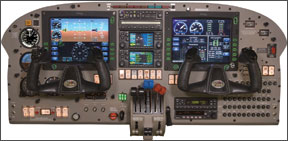
resulting in the PA-44-180T Turbo Seminole.
The 1979 model was the first, introduced a year after Grumman and Beech had begun selling their respective Cougar and Duchess. Piper made 329 copies that first year but subsequent annual numbers have never come close to that peak. Production trickled to a halt after the 1982 model year but restarted for 1989 and 1990. Then, another hiatus ensued. Production has been steady since 1995, however. Fewer than 100 of the turbocharged version were delivered in 1981 and 82, according to the Aircraft Bluebook Price Digest.
The Cougar and the Duchess fared even worse. New owner Allen Paulsen abandoned the Cougar when his Gulfstream Aerospace bought the Grumman line and renamed it Gulfstream American-115 were built in two years of production before Gulfstream pulled the plug. Beech gave in on the Duchess in 1982 after making 437.
Camshaft failures and tappet-spalling were problems with the Seminoles original Lycoming O-360-E1A6D engines. When Piper started making the normally-aspirated model again in 1989, it used an updated engine, the -A1H6. The current production run began in 1995, when New Piper took over.
Except for turbocharging and the improved engines, the original Seminole has seen few fundamental changes over the years. The landing light was relocated in 1981 to allow for radar in the nose. Hot props and wing boots were added as options years ago but the airplane is not certified for flight in icing conditions even when so equipped. Average prices on todays used market for a typical Seminole range from around $80,000 for the premier 1979 model to $130,000 for a 1989 model and $350,000 for a 2005 model, according to the Aircraft Bluebook Price Digest.
As for the competition, prices for early Seminoles are roughly the same as those for the Beech Duchess, which range from $80,000 for a 1978 model to $99,000 for the final 1982 edition (versus $105,000 for the 1982 Seminole). The Bluebook finds a Grumman Cougar, which offers performance similar to the Seminoles with stingier 160-HP Lycomings, will run around $83,000 for a 1978 model and only $1000 more for the final 1979 model, $4000 more than a 1979 Seminole.
Interestingly, the Twin Comanche doesnt fall into the same price range, even though the Seminole was originally conceived to replace it in Pipers lineup. The 1972 PA-39 C/R Twin Comanche-C/R stands for counter-rotating props, like all Seminoles are configured-fetches about $120,000, much more than a Seminole thats almost 10 years newer. In addition to price, the 160-HP Twinkie enjoys an edge in both speed and efficiency.
Performance/Handling
First the good news: The Seminole is forgiving so it is, in most ways, very good for advanced training and for single-engine pilots transitioning to a twin. It has a wide margin of 26 knots between its low VMC (56 knots) and its VSSE (single-engine demonstration/training speed) of 82.
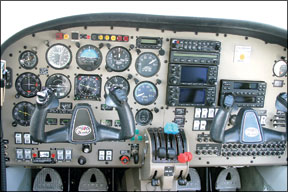
With no critical engine because of its counter-rotating props, a Seminoles single-engine operation is less-demanding than with conventional twins. For all its years of production, the Seminole pops up in only 108 accidents on the NTSB Web site; “only” 24 of them involved fatalities. We identified only three fatal accidents involving airspeed-related loss of control.
Of course, you cant please all the people all of the time: For all its appeal as a trainer, some instructors do consider the Seminoles lack of nasty habits a problem. They say it doesnt teach new twin drivers enough about the challenges of flying with one fan turning and one burning. The idea these days, however, is not to force any twin to demonstrate how nasty it can be, right?
The airplane has been described as handling like a heavy Cherokee, with a sluggish roll response. But even a heavy Cherokee handles fairly well. As a rule, a Seminoles controls are fairly light and we’ll balanced. There’s little adverse yaw in the turns and the T-tail keeps the horizontal stabilizer out of the way so, when flaps are applied and gear is cycled, there’s very little pitch change. Owners have reported there’s a knack to takeoffs with the T-tail. A firm rotation is required to lift off the nose but back pressure must be released quickly to keep from overdoing it as the airplane breaks ground. The same technique works we’ll on other piston-powered, T-tailed Pipers.
Single-engine performance is not great, however, with 212 FPM listed as the single-engine climb speed for the non-turbo; its only 180 FPM for the Turbo Seminole. (A Duchess gets 235 and the Cougar is 200.) A high density altitude and a full load may mean there’s no place to go but down when an engine quits in a normally aspirated Seminole-not exactly news in any light piston twin. Of course, the Turbo Seminole probably does a bit better on one engine than the normally aspirated version when both are at altitude.
A Bonanza or a Mooney, among other singles, can outrun a Seminole. Cruise at 75 percent power is around 165 knots (183 for the Turbo), and 157 knots at 65 percent. Fuel burn for the normally-aspirated model will be about 22.4 GPH at 7000 feet and 75 percent. For the Turbo, it will be 24 GPH at 20,000 feet. At lower altitudes, the speeds between the two are five to 10 knots apart.
Seminoles shine in short-field work. The normally aspirated version needs only 1520 feet to clear a 50-foot obstacle and a measly 1238 feet to land over one. For the Turbo, the numbers are 1500 and 1400 feet, respectively. The airplane has a high maximum gear-extension speed of 140 knots. Full flaps can go down at 111 knots.
Cabin Features
Piper gets good grades for the Seminoles ergonomics and fairly quiet ride. Unsurprisingly, the airplane is as roomy and comfortable as any four-seat Cherokee. And, like a Cherokee, visibility is good, except to the left and right where the engine nacelles can interfere. Its cabin is, however, a little smaller than the Duchesss and-especially in the training-optimized versions Piper is selling these days-is not likely to be as well-appointed.
Another Piper plus, in our view, is the manual flap control, a Johnson-bar handle between the front seats. Its simple, the pilot can control the speed of retraction or extension and its not likely to fail. But note: There is a 1996 AD requiring inspections because the flap-handle attach bolt has been known to do just that.
Its annoying Piper initially put the manifold pressure gauge and the tachometers at the bottom of the panel, on either side of the quadrant. That placement calls for a bit of looking around to establish power settings-not good during times of high workload in IMC. But, anyone familiar with older models of the Seminoles single-engine cousin, the Arrow, will feel right at home.
Piper fixed the issue in the newer models of the Seminole, which relocated all the power gauges to the right of the altimeter and VSI.
We don’t like the fuel-selector setup. Its between the front seats and the pilot has to crane his neck to see it or work it by feel. The selector handle tabs must be moved through the “Off” position to get from “Main” to “Crossfeed,” which is primarily for engine-out situations. The design seems an invitation for a stressed pilot to make a mistake.
There’s only one baggage compartment, located behind the rear seats. It can hold up to 200 pounds.
Owners should know one quirk involving the cabin heater on some models. If they turn off the heater but forget to run the fan for a few minutes afterward, they may very we’ll pop the overheat microswitch, which is in the nose and not accessible from the cockpit.
If they did not reset a popped switch before flight on a cold winter day, theyll be in for some arctic conditions with no way to get the heater going. Make it part of the preflight or, if there’s no heat after starting, shut down, get out and reset the switch.
Range, Payload
The Seminoles useful load of 1394 pounds (its a bit lower in newer models) is roughly what the average A36 Bonanza, Cessna 210 or Cherokee Six can haul. The Turbo can carry about 65 more pounds. A big plus, though, is the Seminoles wide CG range. For a similar article several years ago, we tried to find a way to load the airplane too far aft but couldnt do it. One experiment had 200 pounds in the baggage compartment. We added full fuel (108 gallons-Piper has offered no longer-range options, and were not aware of auxiliary fuel tanks for the Seminole on the aftermarket), put a 170-pound pilot up front and added 272 additional pounds of humanity in the two back seats. The result was legal.
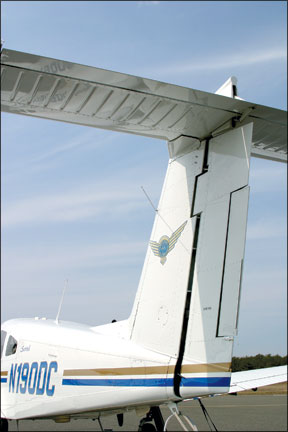
As for range, one mostly enthusiastic Seminole owner wrote us some years back that his only complaint about the fuel system-which he described as simple and well-designed-was the lack of range. He wished for another 20 gallons. The Bluebook gives the maximum range with VFR reserve as 681 NM for the normally aspirated model and 850 NM for the Turbo.
Maintenance
The Seminole is not afflicted with a particularly long list of ADs. Only Seminoles built after March 1, 1999 (a small percentage of the fleet), as we’ll as those whose engines were overhauled after that date, are affected by the infamous Lycoming crankshaft replacement AD issued in 2005.
As with any prospective used-airplane purchase, look over the logs carefully for evidence of repairs after gear-up landings, hard landings and gear failures, which the FAAs accident database shows to have been common for the Seminole. Still, it has proven to be a sturdy ship that, structurally, can take years of training abuse without developing any insidious problems.
With that in mind, know that all years of the Seminole have a life limit of 14,663 hours for the “wing and associated structure,” per the FAA type certificate data sheet and as required by FAR Part 23, under which the airplane is certificated. Given its popularity as a trainer, we wouldnt be surprised to learn some Seminoles have more than 10,000 hours on them. There’s no word on whether that limit might be raised in the future; we wouldnt bet the farm on it.
Over the years, other ADs have dealt with a potential for fire in the Janitrol cabin heater fuel pump, which must be inspected and replaced if leakage is discovered (AD 2003-11-14 was issued in 2003; AD 2005-15-10 superseded and amended it in 2005); cracks in the main gear trunnions, which could cause a gear collapse and require, according to a 1994 AD (94-13-11), repeat inspections until they are replaced.
The nose gear, which the FAA decided in 1994 needed a mod to prevent collapses resulting from a failed bolt (AD 94-14-14); and the control wheel attach point, which a 2004 AD (2004-14-12) targets for inspection because a screw was too short in some installations and resulted in failures.
Other ADs have dealt with the flap-handle attach bolt (AD 96-10-03), binding aileron push rods (AD 80-21-11), damaged skin at the aileron outboard leading edge (AD 81-16-10), a damaged fuel line near the boost pump (AD 79-12-11) and binding in the throttle cable (AD 79-05-11).
That may sound like a lot of ADs for one aircraft type, but many of them went into effect in the first couple of years after the Seminole entered service. Additionally, a few of them apply to other Piper models using the same flap mechanisms, control yokes or landing gear components (e.g., PA-28 models).
Searching the FAAs Web site revealed 418 total service difficulty reports listed for the normally aspirated Seminole, not an unreasonable number for a fleet used heavily in training. Other than reports involving engines, carburetors and propellers, four problem areas cropped up via repetitive entries: landing gear-related problems, including switches and hardware; cracks or other failures of the carburetor airbox assembly; cracking engine mounts and-as the fleet ages in both years and hours in service-increasing wear and tear in airframe components like ailerons, wing ribs and the like.
With the airplane still in production and so few changes to the model over the years, parts are no problem, owners have told us. The Piper Owner Society reports that, over the past few years, members have inquired most about the combustion heater issue and the main trunnion gear inspections. Upgrade them and the requirement for repetitive inspections is eliminated.
Mods/Type Clubs
Owners looking for an airplane that offers a lot of extras in terms of performance arent going to start with a Seminole. For that reason, and the fact that there arent a whole lot of them out there, mod shops don’t focus on it.
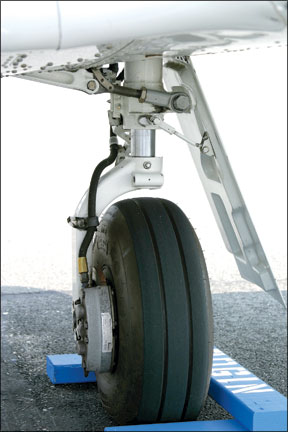
One of the most practical modifications is replacing the original aluminum electrical cables with Bogert Aviation copper electrical cables. They are said to boost cranking power and Piper owners are happy with Bogerts support and service (www.bogert-av.com or 800-627-8088).
Meanwhile, a little extra speed has to appeal to owners of the Seminole. LoPresti (www.speedmods.com or 877-565-1731) has underwing fairings, spats, splitters, flap seals and other hardware. Each can add a knot or two by eliminating drag. Knots 2U, Ltd. (www.knots2u.com or 262-763-5100) has a gear-lobe fairing the company says adds four knots. It also markets a vortex generator kit that reduces VMC and stall speeds for the good-natured Seminole. So does Micro Aero Dynamics (www.microaero.com or 800-677-2370).
If you want to get rid of the center strip that joins the original two-piece windshield, LP Aero Plastics, Inc. (www.lpaero.com or 800-957-2376) offers a one-piece unit with tinting, if desired, and thicker plastic for a quieter cabin. Some airplanes did not come from the factory with the “super soundproofing” option, which had the thicker plastic anyway. The STC is owned by Kosola and Associates, Inc. (www.kosola.com or 229-435-4119), which manufactures and sells the installation kit.
Thats about it for airframe-specific mods. As a rule, however, things like inflatable door seals available for the PA-28 line should also be available for installation on the PA-44. The same is true for one-size-fits-all avionics, engine and fuel monitors, plus items like electronic ignition components for the Seminoles Lycoming engines, and more.
Two type clubs serve Piper owners. The aforementioned Piper Owner Society (www.piperowner.org) is the oldest and probably largest. Another choice is the Piper Flyer Association (www.piperflyer.org).
Owner Comments
I purchased a 1981 Piper Turbo Seminole on eBay. Aircraft total time was 1950 hours, with only 195 on factory overhauls. The aircraft had not flown in six months and required some TLC and avionics upgrades. I operated this plane out of a high-altitude airport in Big Bear Lake, California, for a little over 10 years and found it to be an excellent choice for me.
I had specifically wanted the “T” tail configuration to allow for more storage in my hangar. While I found the turbo Seminole to be a fine performer and easy to fly, I was faced with some serious maintenance expenses early in my ownership. During the second annual inspection, corrosion was discovered in the bottom end of the left engine during a routine cylinder removal. We blamed it on the six months the aircraft had sat in Tennessee and dug deep to cover the ensuing $14,000 annual.
Next came compliance with AD 94-14-11, which required replacement of the right and left landing gear trunnions and another $3500. Other than that, the airplane served me we’ll with minimum down time and routine annuals in the $5000 range.
I flight plan for 150 knots at 9500 feet, burning 21 GPH in cruise with good leaning. Single engine performance was superb with the counter rotating props and 56 knot VMC (about the same as stall speed!).
I put the airplanes excellent single-engine handling to good use several times thanks to the 180 HP E1A6 Lycoming engines (a variant of the famous H2ADs used in the 150 HP Cessna 172s from 1977 through 1980). The first incident was a return to Laughlin, Nevada, after a stuck exhaust valve in the right engine required reducing power to about 25 percent. About a year later, I had to shut down the right engine completely and feather the prop when a rocker arm broke in the same cylinder. This landing was made at my home base with no problems.
I finally sold the airplane due to its declining Bluebook value and insurance costs ($2500 a year for me as a high-time commercial pilot). I will be flying a Cessna 172RG for the time being, but would love another Turbo Seminole in the future.
Wally Weber,
Big Bear Lake, California
I purchased a 1979 Seminole for the unbelievably low advertised price of $34,900. [These comments are from our archives and that purchase was made about 15 years ago. The Bluebook average retail for a 1979 Seminole today is $108,000. – Ed.] Both of the Hartzell two-bladed props were at the end of a five-year AD inspection limit, which I believe has since been rescinded for Part 91 personal use. One blade flunked inspection and was replaced for an additional $2000.
Since the aircraft was purchased for leaseback revenue at military flying clubs in the Northwest, it was in fine condition. During that time, both engines made it to the 2000-hour TBO,
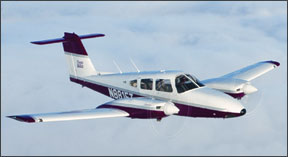
plus or minus three percent, without any problem. The O-360 engines originally installed in the Seminole had a cam problem service history, which resulted in an AD requiring Lycoming snake oil additive and time limit oil changes and examination for filter particulates. Speaking of oil changes, there’s not enough clearance between the bottom of the engine oil pan and the access plate to allow installation of a quick oil drain kit. The good news is that the upper engine access cowlings are easy to pull off and re-install.
The fuel system is simple and easily checked for contaminants. My only complaint about fuel is the lack of adequate usable fuel quantity for use as a personal long distance cruiser. Another 20 gallons would have enabled non-stop flights from Monterey to Seattle. I flight plan for 18 to 19 gallons an hour at 138 to 142 knots at 55 percent power. At 22 inches and 2300 RPM, the ride is reasonably quiet.
The landing gear is a simple electric motor driving a hydraulic pump to operate the wheel retraction cycle following a cross country fuel stop. The emergency extension system is a simple matter of pulling on the gear handle to release the hydraulic pressure and allow the springs to push the gear down.
Electrically, the only negative memorable event occurred over the Pacific Ocean near Catalina Island as smoke and smell started to exceed the denial stage. After securing all electrical power, we started reenergizing systems on line slowly to isolate the problem. It was a shorted strobe-light capacitor box which is mounted on the aft floor bulkhead. I replaced the box and still had problems, which I was never able to resolve. The single landing light bulb in the nose frequently burned out. Its definitely a preflight item for night ops.
Another problem related to the alternators. Occasionally, one alternator would not stay paralleled and the other would pick up the entire load. The fix was a small screw adjustment in the paralleling circuit box under the nose cowling that required tweaking.
Airframe wise, the only gotcha is the Cherokee-type single entry door. After briefing another pilot on proper door closing technique, I didnt check his work and it popped open after takeoff; we managed to close it after a struggle.
As for the instrument panel and related switches, these are laid out acceptably. The engine RPM gauges are low on the panel and the MP gauge is on the right side. You get used to it because you have to. The side panel-mounted engine starter controls and light switches are fine when there is ample light to read which is which. The Janitrol heater controls are on the right side and work fine.
The Seminole is easy to fly we’ll and will not bite unless severely provoked. It flies like a heavier Arrow, with a bit more roll heaviness. The T-tail is great for walk-arounds and the horizontal stabilizer is not susceptible to rock/gravel damage blowback from a swinging propeller.
Takeoffs are more like a launch when the aircraft gets to flying speed. The aircraft does have to be pulled into the air at 75 KIAS and shortly thereafter requires a bit of forward yoke to readjust the pitch attitude. On landing, it takes true skill to hold off the nosegear for a smooth letdown after main gear contact since the horizontal stab dies almost immediately.
Control pressures are light and gentle on the Seminole, as opposed to the solid sports car/high performance feel of the Twin Comanche. The Seminole is not a fast airplane. Its about 25 knots faster than a Cherokee 180 at only twice the fuel burn. The Seminole is easier to slow down and configure for approach and landing than is the Twin Comanche.
Steve Bulwicz,
Bloomington, Minnesota
I have owned a 1981 Turbo Seminole for about three years. I am the third owner of the plane. It has a total of 1200 hours on the airframe and about 600 hours on the engines. The airplane is as close to flawless as a 1981 airplane can be. The plane is equipped with dual Collins Microline nav/coms, a Century 41 autopilot, an IFR-certified KLN 90 GPS and radar altimeter. An NSD HSI (unslaved), fuel totalizer and Strikefinder round out the package. Its also got three-bladed hot props.
I maintain the plane meticulously. Annuals have averaged $4000 a year and insurance is about the same. I replaced the aggravating heater that has an AD on it with a ceramic-lined heater that does not need annual inspections. On runup, I have always had to lean the engines for a moment prior to checking the mags and the airplane is a smooth and stable and forgiving machine with counter-rotating props (why doesnt every twin do this?) and no critical engine.
Its a wonderful airplane for two people. I have flown with four people, but that is cramped and I do not carry full fuel then. I can carry full fuel (108 gallons) and burn 20 gallons per hour at 65 percent power and cruise at 160 knots. I have dual vacuum pumps, dual alternators and two engines! With two people, the airplane will fly and gently climb with one engine at zero thrust (11 inches of manifold and 2200 RPM).
I am surprised more Seminoles are not sought out for their safety and redundancy. If not overloaded, I cannot imagine a safer airborne machine. I received my instrument rating in the airplane and am a very conservative IFR pilot in terms of weather.
Robert B. Tober, M.D.,
Via e-mail

